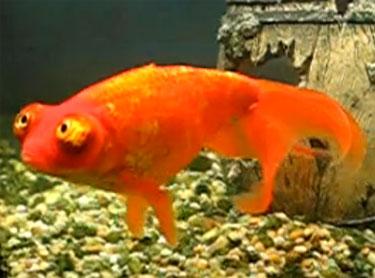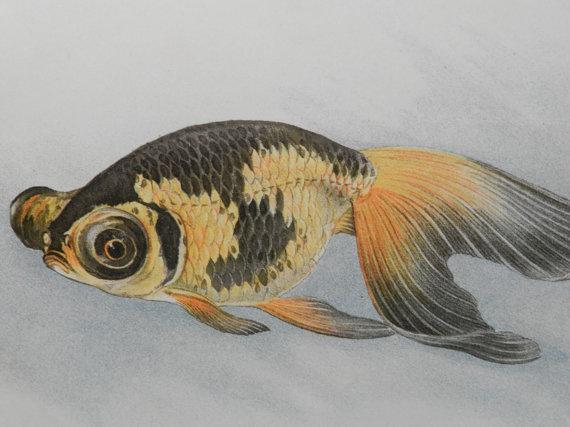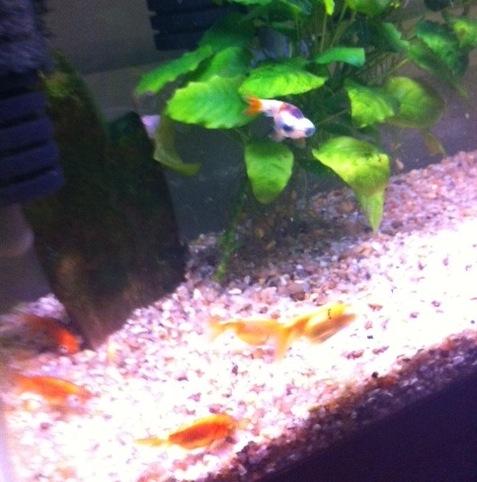Goldfish Culling - Celestials page 6 / 6
As with Telescopes, the eyes of a Celestial may present themselves in several shapes. The most commonly seen are globes and cones. Either is acceptable so long as it�s a matched pair. In this photo, the fish to the right has a conical pair while the fish in the center has a globular pair. The fish to the left also appears to have a pair of globes, but they seem to be still developing:

And here�s a photo depicting the often-seen Bubble Eye-like sacs that can develop around the eyes of some Celestials:

Here�s an adult pet store Celestial with impressive depth of color (for a Celestial) but with forward-facing eyes, and a �knob� on the back:

Precocious and excessive eye development often indicates the fish will be a runt, as precocious and excessive caudal development suggests in other varieties. This youngster is a likely runt:

In some sources, Celestials are referred to as Deme-Ranchu, which were in fact telescope-eyed Egg Fish. All Celestial spawns will include some fish of this type whose eyes do not progress beyond telescopic, which perhaps reflects how Celestials were developed, and points to their relationship to both Egg Fish and Telescopes. Here�s a portrait of a Deme-Ranchu from Matsubara, circa 1905. Note how in every other way but eyes, the form of the fish is identical to that of a Celestial:

Now compare the above to this photo of a Celestial nearly 100 years later, circa 2003. Had the eyes not turned upward (and as it is they are a bit forward-facing) the two fish would be nearly identical:

One final thought about eyes and culling: it is important to me that my fish can see. All Celestials are vision-impaired to some degree. Some are near blind and some are totally blind as a result of retinal atrophy that occurs as the eyes journey to the celestial position. The better they can see, the more active and agile they are. A sighted Celestial with a long, flowing caudal is, believe it or not, an elegant swimmer and even a pretty thing to behold. That�s right, I said pretty. The less well they see, the more likely they will be bottom-sitters and skittish shade-seekers. Furthermore, the better they can see, the more efficient and reliable they are as breeders. I�ve also noted over the years that the better-sighted fish tend to grow the largest and at the fastest rate, which makes perfect sense since they are better equipped to compete for food. Sight is the most important feature I select for. It is also usually the thing for which I need to wait the longest in order to evaluate, and almost always contributes mightily to the decision as to which fish will be my breeders.
This has always been a solitary though pleasurable pursuit for me since few, if anyone, seemed to share my enthusiasm for these funky little creatures. Or perhaps Innes said it best, as he often did, when he called them �most extraordinary.� I think he also captured the essence of why they appeal to me when he wrote how in many ways they embody an essential and age-old aspect of some Asian art, which initially challenges the viewer with something that might at first glance appear grotesque, and then invites the viewer to find the beauty and pleasure in it. My pleasure is all the more enhanced if I can look into one of my aquariums�which are an integral part of my home, and not in a basement or garage�and see animated, healthy Celestials swimming about through all strata of theaquarium with grace and gusto. Especially if they are, say, promising 14 week-olds and I bred them. And yes, I take a lousy picture.

If you�ve slogged through all of this, well, thank you for your interest and attention. And thank you, Dave, for asking me to put my thoughts down in writing.
Bruce (a.k.a. �Celestial�)
Previous Page





